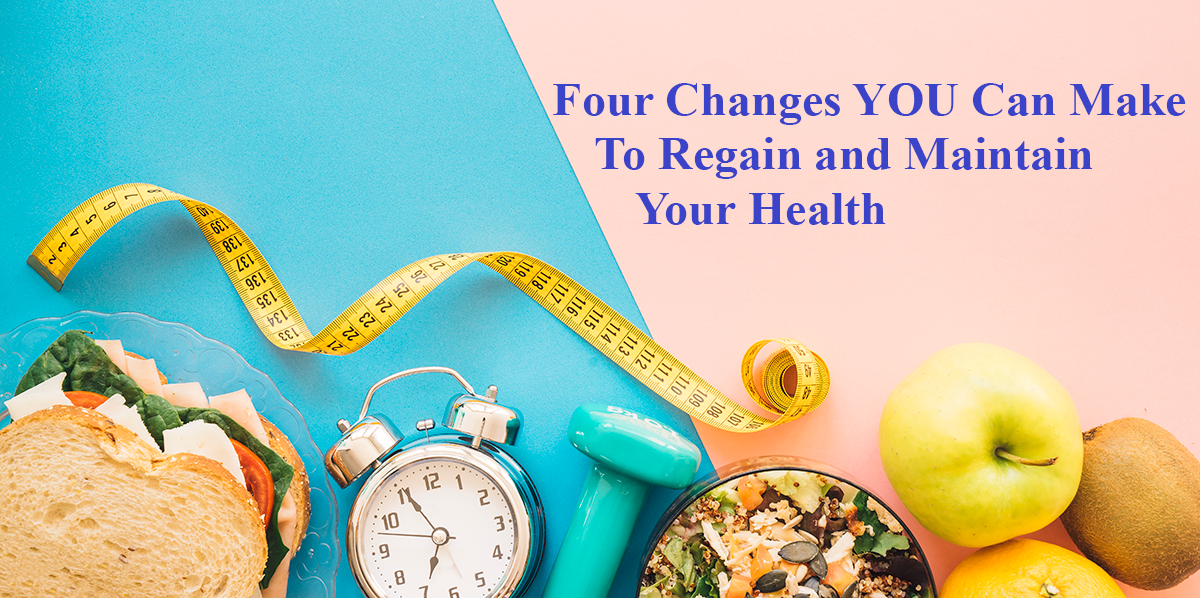
Several years ago, I had a bit of a health scare. I had just left a high-stress job about a year prior, moved my family 1500 miles to a new city to take on a manager position at a major convenience store chain, working at their corporate offices to build a technical call center, from scratch. As you can imagine the stress from the previous job, the move, and the new job took its toil. Within the first year, I was dealing with High Blood Pressure, and by the 2nd to 3rd year I developed Type 2 Diabetes all before the age of 50. I weighed 240 pounds, had a poor diet and sleep habits; you name it. It was awful and terrifying. My wake up call, unfortunately, was the Diabetes diagnosis. A1C of 13 and a glucose level of about 300 and a nurse telling me that once I have this diagnoses, that is it, it is with you for the rest of your life. So defeated, scared and wondering what will happen to my family if I am gone, I did some research to get the facts about my illnesses and what I can do to get rid of them or at the very least, minimize the effects.
The following are the specific steps I took to deal with my issues. These may not work for everyone, but for the last 12 years, these techniques and lifestyle changes saved my life. I hope they provide a benefit for you as well — no hype, just what I did to regain my health.
NOTE: I am not a doctor or a medical professional. What I state below is based on my experience alone. If you plan to use any of the suggestions stated in this article be sure to consult a medical professional FIRST! (See Disclaimer Below)
My Results:
Following the program, I put together over some trial and error; I was able to bring my A1C down from 13 to 5, my glucose readings from over 300 to normal (85-100) and my blood pressure to 120/75 in a matter of about eight months. I also got off all my medications except for one to control my cholesterol. In addition, lost 65 pounds, going from 240 to 175 pounds and from a 40 inch to a 33 inch waist. I will always have to be mindful of my risk factors, however maintaining of my current state of health in this way will hopefully minimize or avoid complications as I get older.
1. Get a GOOD Doctor and a FULL check up.

I have been blessed to have a great team of doctors work with me over the years. When I moved to the East Coast in 2007, I had to shop around for a while to find a good physician. I had a few that would prescribe some medicine just to treat the symptoms, do very little, to no tests at all, and were not focused on preventive medicine. When I finally hit bottom, I fortunately ended up at Mainline Healthcare and found a doctor in their practice that focused on what was
truly going on with me and worked with me to create a plan to get my health back.
Know and Understand Your Numbers
Stress alone can cause a lot of problems with your health, and you don’t even know it is happening at times. If your borderline diabetic, it can increase your sugar levels, mess with your sleep patterns, increase blood pressure along with emotional symptoms. All this to say, it is better to know what is happening in your body that just how you may feel on a particular day. So get your numbers checked. A full lipid panel, A1C, glucose, blood pressure are a good start. If you happen to be on any other medicines, like for Cholesterol, have your liver enzymes checked. If you think you are close to becoming diabetic (high glucose levels) have your kidney’s checked as well. Also, if your tests come back with a risk for diabetes or high blood pressure, follow up with your dentist and eye doctor to have your teeth and eyes checked. Be sure to tell them about your risk factors so they will do the proper screening. It is far better to know where you are and what you need to deal with than to not know and hope it will just go away. It won’t if you don’t take action to reverse course, but you need to know where you are and establish a baseline.
Establish A Controlled Baseline
If you happen to have developed any chronic illness like diabetes or high blood pressure, get on medicines to get your numbers back into control. Some doctors may, at first and depending on how bad your numbers are, recommend trying to control it first with diet and exercise. That may be OK if you are at a borderline risk of developing the disease, but don’t go too long under that condition, especially if you are not able to make the proper adjustments to reverse course, such as changes in your diet and exercise. If your numbers are off, but the doctor feels it can be controlled without medicines, check back within three months and have your tests re-run. Use that time to focus on those lifestyle changes and see if your numbers are heading in the right direction (see further in the article on specific steps to take). If your numbers do not get much better or end up getting worse, discuss with your doctor about using medication to get your readings back in line. The reason for this, especially when dealing with metabolic illnesses, is that your body could be so out of balance, diet, and exercise alone won’t be enough. But again, weigh the risk factors of that decision as you want to get to a point where you are NOT taking medicines to deal with your health, but instead, you have made significant lifestyle changes to maintain a healthy balance and control your numbers.
Monitor Your Numbers and Keep Regular Check-Ups
Once you have established your baseline, follow up with your doctor regularly. If you are dealing with a chronic illness, you may have to get your blood work checked, 2 to 4 times a year. Your doctor may recommend less frequent visits if your tests are within a controlled range. Self-monitoring is essential if you have diabetes, high blood pressure or are overweight. Monitoring your glucose levels daily (or more depending on your condition) is a must. If you have high blood pressure, get a monitor and check it once a day. In my case, I check my weight, glucose and blood pressure once a day and log it. Most monitors have a log tracking system, and some will interface with apps on your phone. Your employer’s Wellness Programs may also have solutions that allow you to keep track of your numbers.
Don’t panic if your numbers go up in a particular reading. Focus on overall improvement each week. Average your numbers weekly and compare that trend. If a reading happens to go up, let’s say a morning glucose reading, figure out what you might have eaten the night before and see if you can make a change there. Small changes over time, make a significant impact in the end
2. Don't Diet, Make A Lifestyle Change

The hardest thing for people to do, especially if you are dealing with a significant need to lose weight, is to change your eating habits. As I stated earlier, I weighed 240 pounds, for my size, I was at least 80 pounds over my ideal weight, hitting the obese level of my BMI. I enjoyed the weekly chocolate milkshake, a candy bar here an there, bowl full of sugary cereal (thinking that was healthy), just an inferior diet. I sought sweets as a way of dealing with stress; it was a never-ending cycle.
Given my wake up call, which has been a significant motivator, I took the prescribed dietary courses my physician recommended and learned a few things about preparing healthy meals and maintaining a balanced diet. If you are anything like me, I strongly recommend following through with a dietitian as you learn a tremendous amount about food and how your body uses it. For me, it also started me down the path of really looking at “diets” entirely differently and their actual effects on the body. Focus on mastering the basics. Here are a few things you can do to move to a much more healthy lifestyle in your eating choices in a short period of time.
Remember 45-10 rule.
You may have come across an article or two about how eating more frequently helps you lose weight. This frequency rule is true with one caveat, making sure the size of the meal is not over indulgent. If you love food and are struggling to lose weight, a simple method to start getting this under control is the 45-10 rule. For each main meal (Breakfast, Lunch, and Dinner) make sure your overall carbohydrates are between 30 – 45 grams TOTAL. Carbohydrates are the fuel your body runs on, but too much increases sugar in your bloodstream and the excess that is not used (burned by your body’s metabolism) gets stored as fat. So keeping your carbs under this amount per meal cuts down your portion size and keeps you from having to count calories. For in-between meal snacks, which two per day is allowed, you would consume 7 – 10 grams of carbs for those meals.
Using this method also makes you keenly aware of what you are eating. For example, my weekly milkshakes went away, and I replaced them with a protein shake as a snack after a morning workout. An average 10-ounce milkshake contains approximately 40 grams of carbohydrates. And that is just 10 ounces. Think about the typical serving sizes of your local burger joint of 24, 32 or 44 oz! My protein shake has less than 12 grams of carbohydrates, and of that, only 4 grams are sugar, the rest is fiber, and that is for an 8-ounce drink. That is a significant difference.
Not to mention, you also get into the habit of looking at labels more closely. Reading and understanding label content was an astonishing experience for me in the beginning. What you realize is that the typical U.S. diet has a high percentage of sugar. In fact, just about everything has sugar or worse, high fructose corn syrup which is concentrated sugar and harder for your body to metabolize. I stay away from individual items that have more than 5 grams of sugar per serving and watch anything I am combining to make sure the overall sugar content is less than 20 grams of sugar per serving. For example, if I want a peanut butter and jelly sandwich, that is 4 grams of sugar for the peanut butter, 1-3 g of sugar for the bread and 0 g of sugar if I used sugar-free jelly, making my serving approx. 7 g total of sugar, but the total carbohydrate count is approx. 14 – 20 g per serving due to the fiber content. That is why you can’t just look at sugar alone. You need to look at the total carbohydrate content.
Combine a Carbohydrate with A Protein
Another simple trick, especially if you are struggling to control your sweet tooth, is to combine a carbohydrate with a protein during your meal. The enzymes that are used to break down food for starches are different than those that break down proteins. As such, your body has to continually switch gears, so to speak, to break down both when you eat a carb and protein at the same time. This combination has the effect of slowing down carbohydrates entering the bloodstream. You still want to maintain portion control based on the 45-10 rule, but this is an excellent way to keep from having sugar spikes and keeping your metabolic rate more stable.
Anything Green is Good
If you have to watch out for starchy, carb-packed foods, remember that almost all green vegetables have a low glycemic index value. They partner well with any protein and provide plenty of nutritional value including essential vitamins and minerals. Whenever I dine out, my go-to is always to pick my sides as green as possible. Keep to anything steamed or grilled. Be careful on dishes that are sauteed, fried or creamed. Keeping things green when your not sure about the amount of carbohydrates a restaurant entree may have is a useful and quick tip that will help you stay on your eating plan.
Drink More Water
The human adult body contains about 70% water. Water is used in a variety of ways in our bodies, from digestion, circulation, elimination of toxins, enzyme balance, brain function, regulating body temperature and contributing the millions of chemical reactions that occur every millisecond of our existence. So when the body does not get enough water, which statistically most Americans DO NOT drink enough water daily, things start to go wrong. We don’t think clearly, we get joint and muscle aches and inflammation, our organs strain to keep their processes going, and we become more susceptible to illness and chronic diseases.
How much water should you drink? That depends on your daily activity. If you tend to exercise a lot, work outside in the sun, you will lose more water than if you are working in an air-conditioned office. You have probably heard the basic rule of needing to drink eight 8-ounce glasses of water per day. That is a handy rule of thumb, but you may need more or even less depending on your body’s needs.
Two easy ways to check to see if you are properly hydrated are 1) Do you rarely feel thirsty and 2) is your urine is colorless or light yellow? I tend to go with the latter test more. If you are dealing with a chronic illness, like diabetes, you may be excessively thirsty due to the glucose levels being uncontrolled and/or high (a classic symptom of the disease, which is another reason to have your readings under control). Both techniques will work if you have first, establish a controlled baseline for your biometrics.
Close the Kitchen after 8pm
Avoid having late dinners or late-night snacks after 8 pm. Stick to water or a decaf tea or coffee to curb your appetite. If you to have something to fill your tummy, keep to protein. You can have a couple of 100% beef hot dog wieners, no bread, no sauces as a quick snack. Add a stick of celery with a tablespoon of fat-free dressing to go with it (Remember green is good!).
At night, your body starts to slow down. When you are asleep, your body enters the elimination process of your digestive cycle, getting rid of toxins and clearing the digestive system. So loading up on chips, sodas or candy counters this effect, staying in your system longer overnight, and getting stored away as fat. You want to keep your body burning fat. So, giving your body a break and let it do its thing.
A cardiologist once told me that the best prescription any doctor can give a patient is, to exercise. Purposeful physical activity has a tremendous benefit to the body. It helps you lose and control your weight, decreases stress, decreases the risk of chronic disease (and in some cases reverses those conditions), promotes better sleep patterns and more restful sleep, increases endurance and body strength, and the list goes on. Here are a few tips to help you get started and stick to a good exercise program.
3. Exercise, Exercise, Exercise

Keep It Simple
When most people are faced with the challenge to get into shape, they go out and get a gym membership, start hitting the weights hard or going on a treadmill at 9 miles per hour like they were a teenager and expect to get up the next day and do it all again. Yeah, Right? They end up waking up the next day, barely able to move, avoiding the gym altogether the following day, which all ends up, weeks and months later, with them paying for a gym membership they will never use again. Just stop. Remember, small changes, consistently over time, make huge gains.
Realize that your body has probably not had any intense exercise for a long time. So start slow. 20-30 minutes twice a week is all you need to. Go for a brisk walk (not a run), ride a bike, take up yoga, or take a swim. Consistent activity to get your heart rate up to its target rate for your age and hold it there for about 20 – 30 minutes is the main thing you want to achieve.
When I started, I committed to this exact timeline, regardless of what happened during the day or week, I was going to get my two days of exercises in for at least 30 minutes per day. I still keep that commitment today even though I now do a six-day, one hour workday per week routine. But if for some reason, I have a terrible week in which my schedule gets too packed or whatever, I have only promised myself two days a week for at least 30 minutes, so anything else I do is a bonus. That simple philosophy has allowed me to gradually increase my activity in an acceptable pace without me putting pressure on myself to keep to an unrealistic workout schedule.
Monitor Your Activity
A good motivator, as well as a way to target your cardio exercises, is to get a good activity monitor. A FitBit™ or similar tracker works excellently to keep you geared to gradual improvement as you can set goals for yourself by tracking your eating, sleeping, and exercise. Counting steps seems to be a topic of conversation at conventions I attend where everyone is comparing their counts. It has become a social motivator as it challenges you to go beyond your daily work to get a few extra walking steps in each day. You can even make this a job or club competition to where participates form teams and add up their walking steps for a month or so to see which team walked the farthest. Little things like that make for great personal motivation to keep your exercise on track.
Also, it is a good idea to get a tracker that measures your heart rate when exercising. While FitBit™ and similar wrist trackers have this feature on some models, I have found them not to be very accurate. For this purpose, I have a Pulse heart rate monitor that has a sensor that wraps around my chest with a wrist receiver to monitor the rate. This type of fitness tracker is great for weight training as well, because it accurately measures your heart rate so you can make sure you are exercising within your target range. I do use my FitBit™ to track my regular activities, but if I am doing some intense workout or running, an accurate heart rate monitor is a better choice for targeting your workouts to get the most benefit from your efforts.
Add Resistance Training
When beginning a workout routine, cardio workouts are probably the easiest to maintain, but eventually, you might want to add some resistance training to your routine. Resistance or strength training does not need to be overly complicated. All you need are a few free weights and a bench and your good. Even resistance bands can provide quality results when starting.
In addition to a good cardio workout, resistance training has shown in some studies to reduce the risk of Alzheimer’s and muscular/skeletal diseases. It also tones your body in target areas that cardio exercises may not. Strength training provides stamina and strength to your body and enhances your mental acuity. Finally, it is proven that the weight loss effects of a resistance/strength training workout session last 3x longer than cardio training alone. What this means is that your body continues to burn fat from a strength training work out two days longer than cardio workouts.
4. Use Supplements, But Don't Go Overboard

My focus on getting my health back was to do so without having to depend on prescription drugs. If at all possible, I wanted to keep things as natural as I could. However, eating pure organic food or being on a restrictive “diet” was too hard for me to sustain. So I looked into supplements that would ensure I was getting the right vitamins and minerals I needed.
What I developed was this little vitamin cocktail that I can honestly say, made a huge difference in not only how I feel every day, but improvements in maintaining my health goals, such as weight loss goals and biometric readings.
My Daily Supplements:
2 – MegaMan Men’s (GNC)* vitamins twice a day (morning/Mid-afternoon)
2 – 1200 Fish Oil capsules twice a day (Morning/Mid-afternoon)
2 – 500 – 1000 mcg Biotin tablets twice a day (Mid-afternoon)
*-GNC also has a vitamin series tailored for Women called MegaWomen.
That is all there is to it. Very simple, but very useful. However,here is a word of caution. If you happen to be taking iron supplements due to anemia or other similar condition, get a vitamin that does not contain iron as too much iron can cause significant health issues including death. Also, if you are taking a B-Complex vitamin, take one or the other but not both as excess niacin (a B Vitamin) can damage the liver. In short, don’t go crazy with supplements. A good, all around multivitamin is sufficient. Also, Fish Oil or Flax-seed Oil are good sources of Omega 3s which are shown to control good levels of lipids (Fats) in your body. Biotin, usually associated with stronger nails and hair growth, also help in the area of metabolism. So, if you are looking to help balance out your fat burning engine, this is a good bonus supplement that naturally eliminates from the body. The body absorbs as much as it can use, then removes the rest. In my own experience with Biotin, it seems to help to balance glucose levels.
Putting It All Together
As another medical professional put it, “Eat Less, Exercise More.” That is it in a nutshell. Small changes, consistently, over time lead to considerable improvements in the end. Celebrate the small successes and don’t beat yourself up if you fall off the wagon. Get back up, and keep moving.


